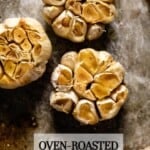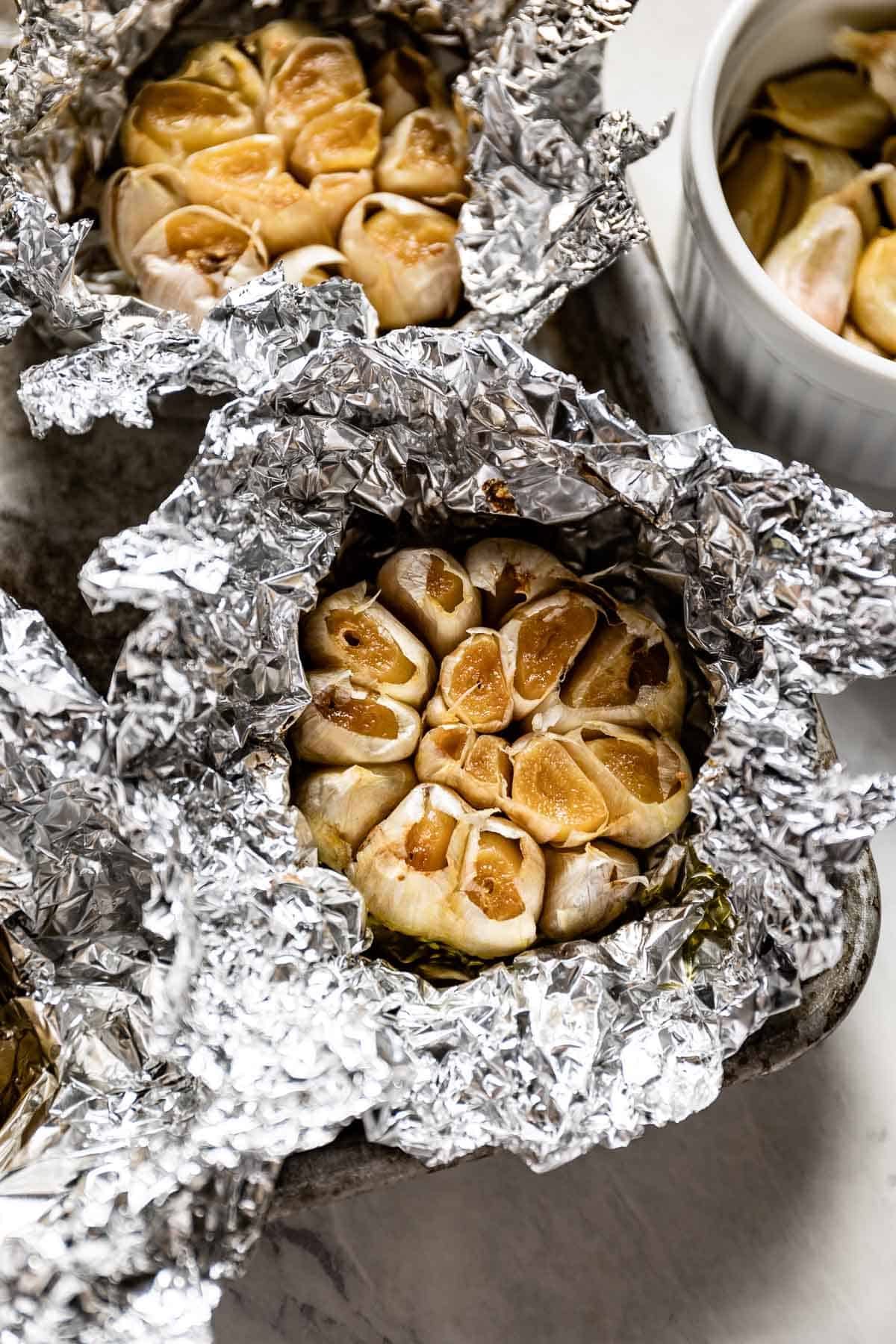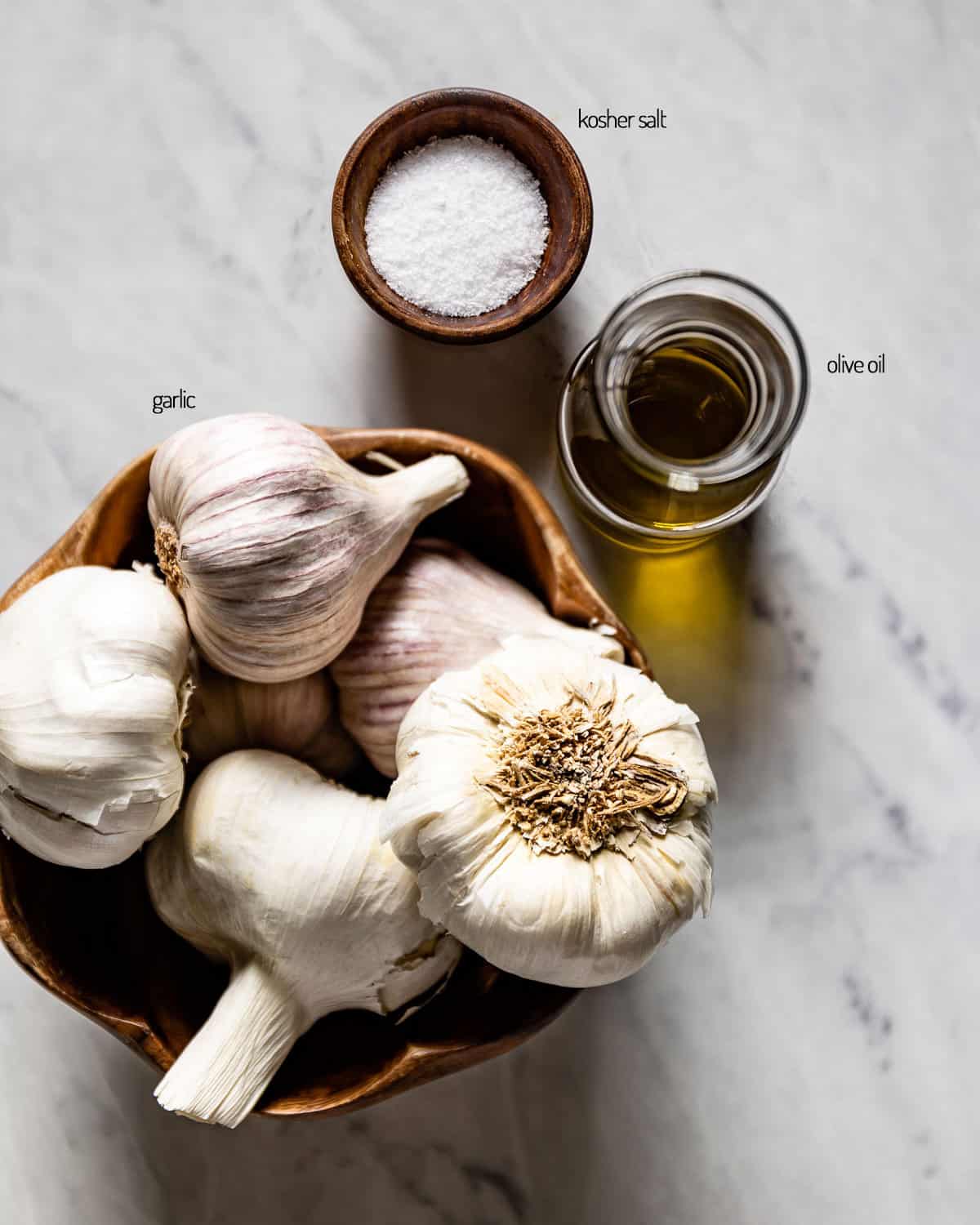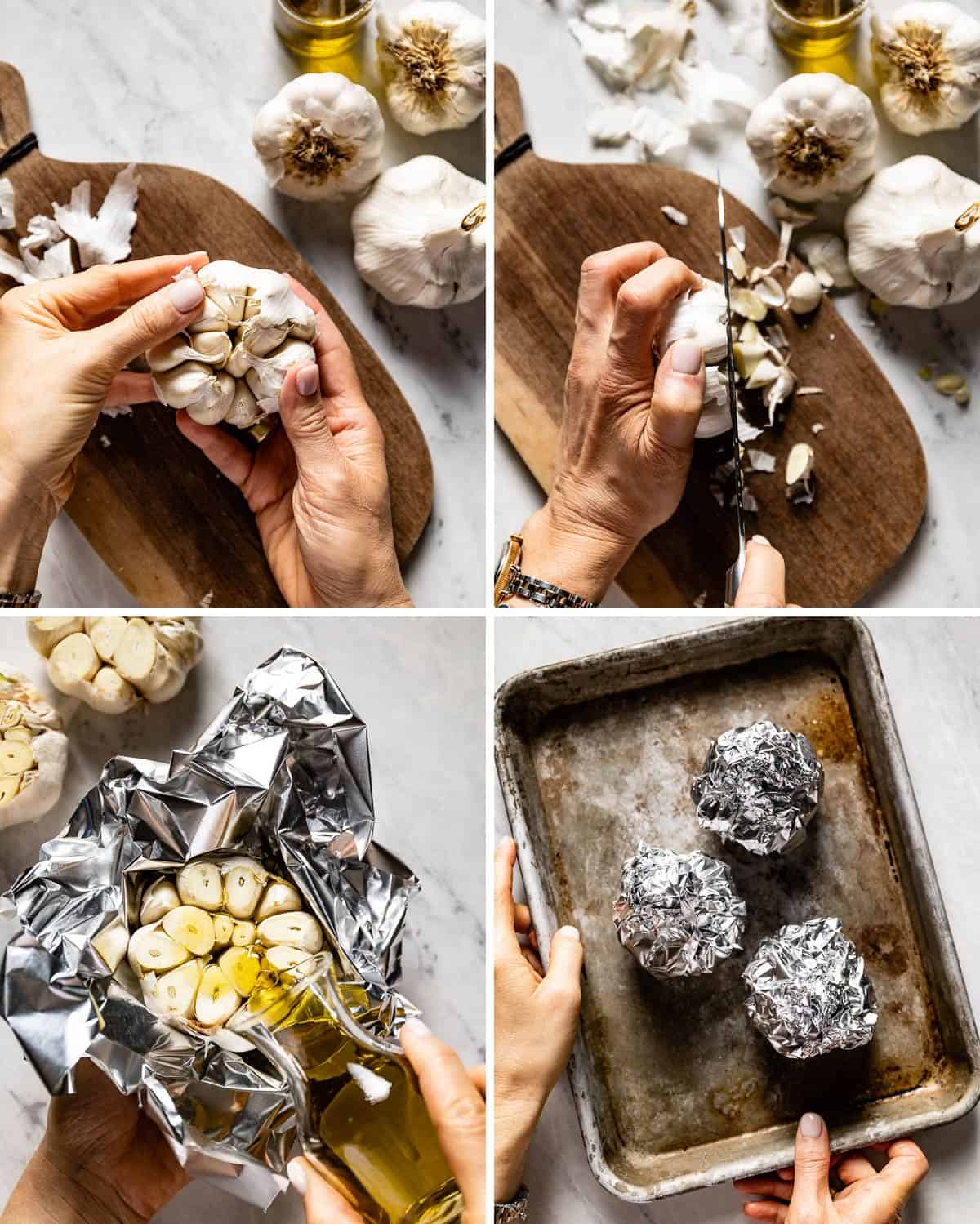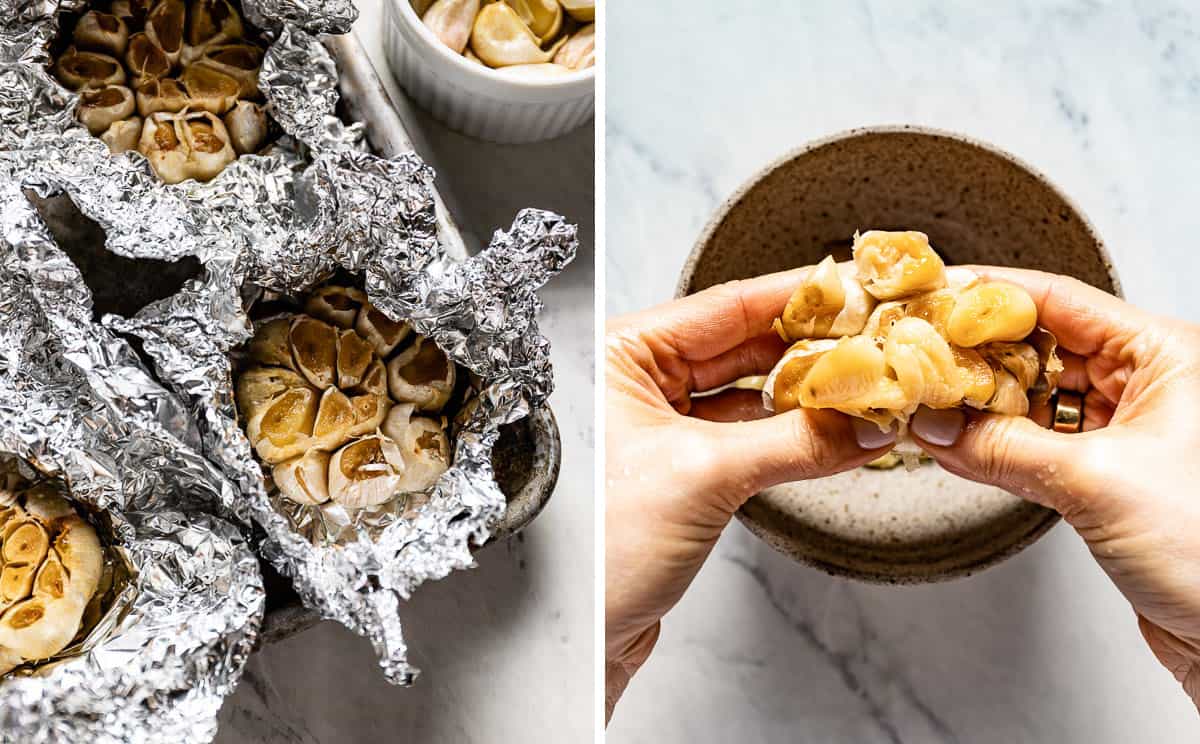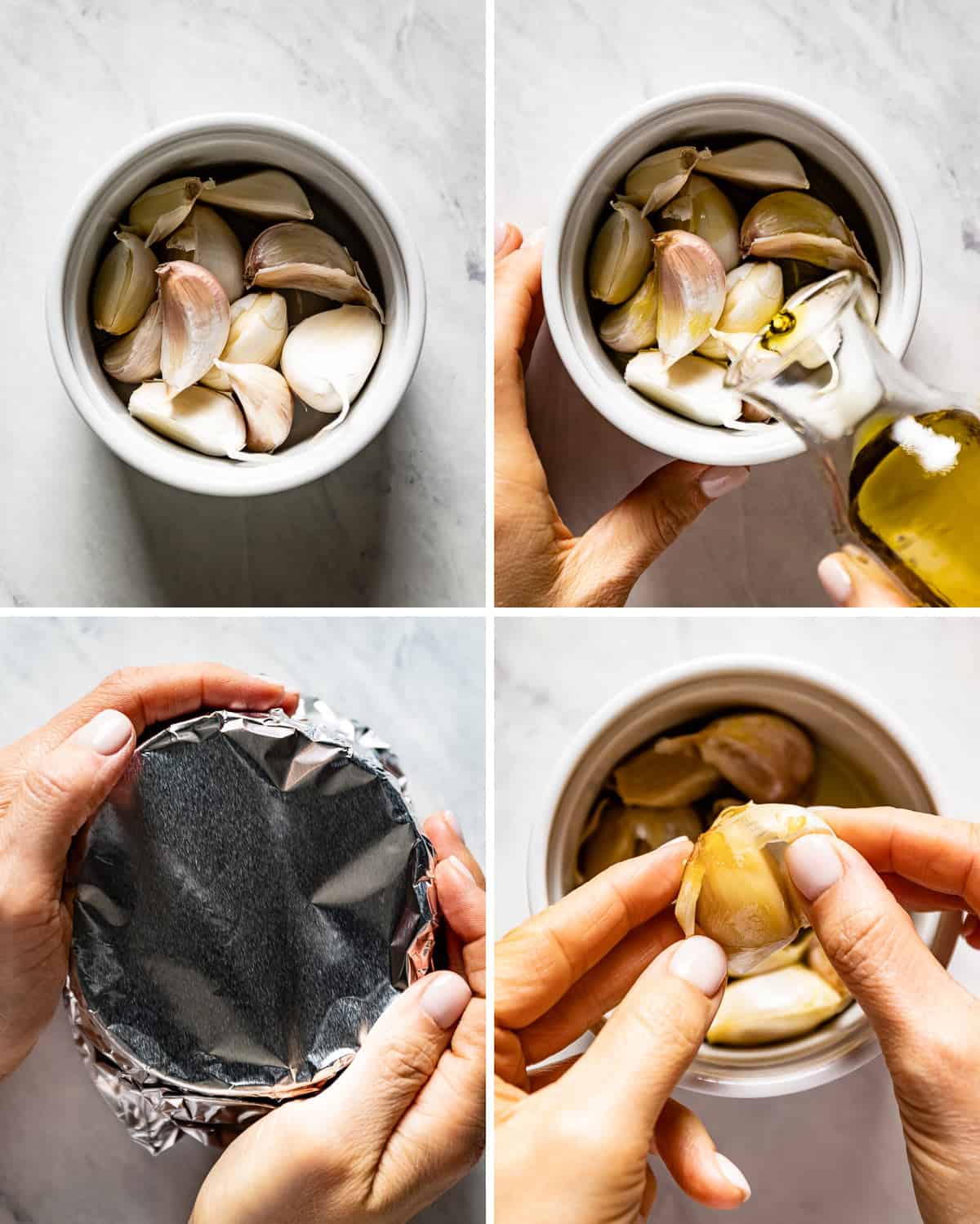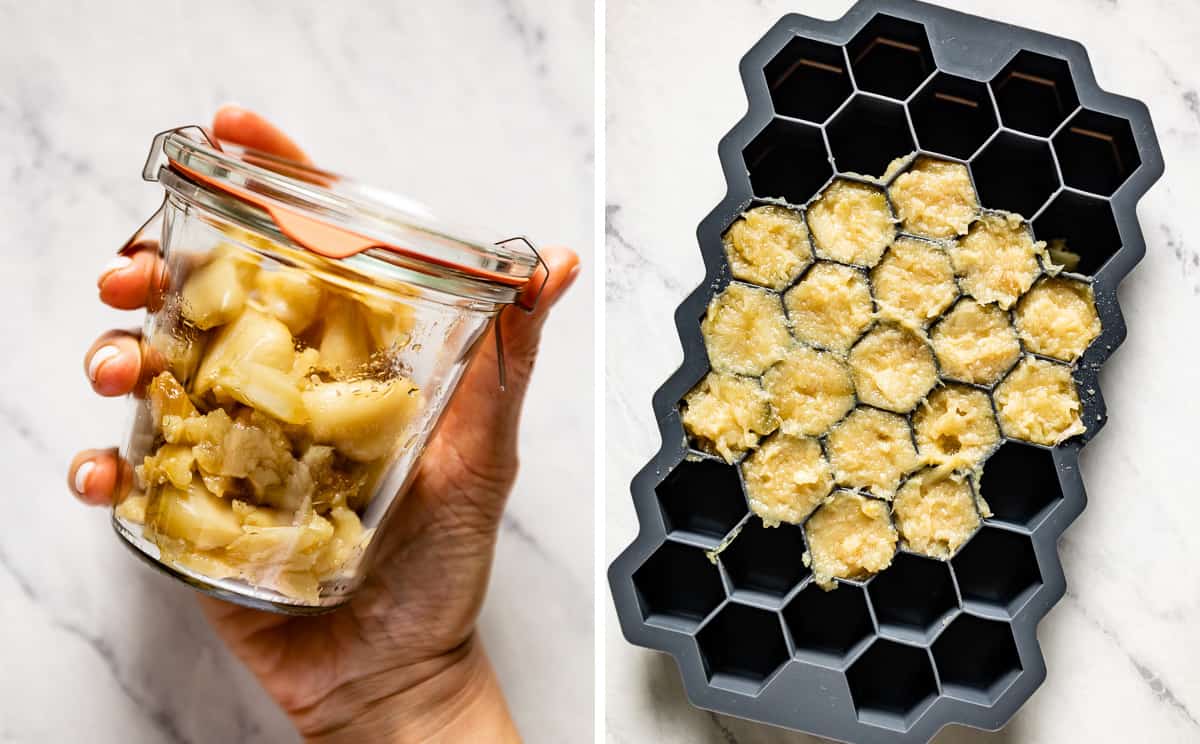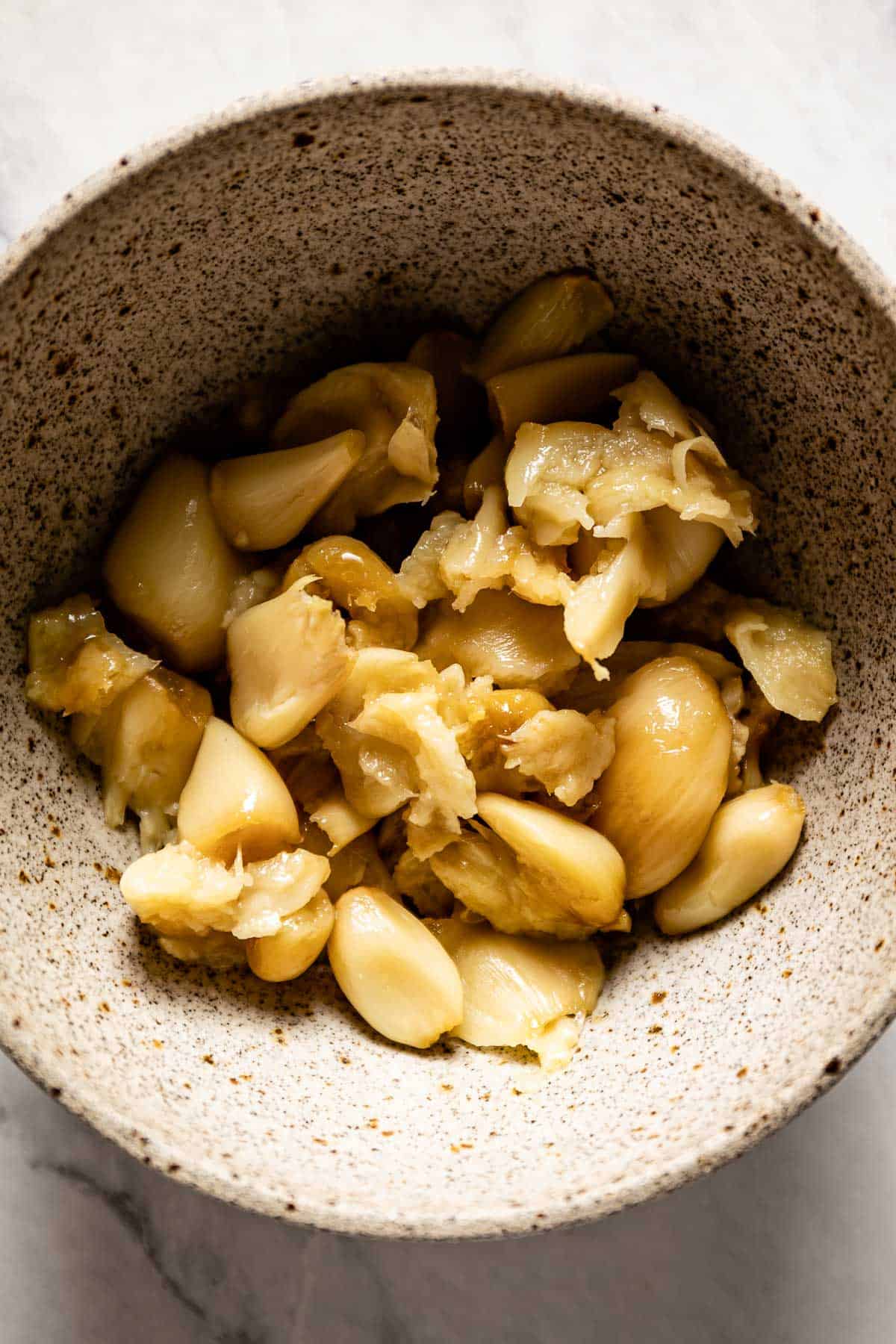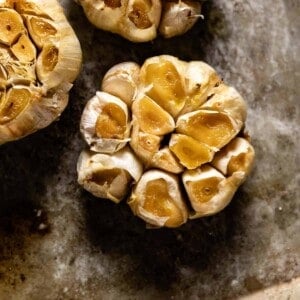Recipe Ingredients
To make this roasted garlic recipe, you will need two simple ingredients: garlic and olive oil. You can follow the recipe below to roast one whole garlic bulb or more. You may also add salt for additional flavor, but it is optional. When selecting heads of garlic, look for firm, fresh bulbs that don’t have any soft spots or mold. Avoid old garlic that is dried out or has green shoots growing inside.
Best Garlic For Roasting:
This recipe will work with any type of garlic, but I think the best garlic for roasting is artichoke garlic. Artichoke garlic, or “soft neck garlic,” is the most common variety in grocery stores and has a delectably mild taste. For a sweeter, more full-bodied variety, you can also use rocambole garlic (also known as “hard neck garlic”). You can also use this recipe for baked elephant garlic—a much larger variety of garlic that tastes similar to an onion. However, oven-roasted elephant garlic will require more cooking time due to its size. Though I use olive oil in this recipe, any neutral oil, such as avocado oil and ghee, would work.
How to Make Roasted Garlic
Roasting garlic in the oven is an easy yet vital tool for any chef who likes bold flavors. Below are two simple methods for making homemade roasted garlic like a pro:
Seasonings: Adding a pinch of salt and black pepper is the easiest way to enhance the flavors when baking garlic in olive oil. While it is optional, if you are using the roasted garlic on its own, I would recommend seasoning it before roasting. Fresh herbs: Nothing balances the bold taste of oven-roasted garlic cloves better than fresh herbs. Chopped rosemary, fresh thyme, and parsley are just a few of my favorites. Butter: To enhance the rich flavor of your whole roasted garlic cloves, try using butter instead of olive oil.
Method 1: Roasting Whole Garlic Heads
Here is my hands-free method for making roasted garlic in aluminum foil. The recipe below can be made with one head of garlic or more.
Method 2: Roasting Individual Garlic Cloves
If you’re on a time crunch, a faster way to roast garlic is to roast individual garlic cloves. Follow the steps below to cut your roasting garlic time in half.
How Long Does it Take to Roast Garlic?
When roasting a head of garlic, I recommend setting your oven to 400 degrees F and baking the bulbs for 40-50 minutes. However, roasting time may vary depending on your garlic’s size, variety, and age. You can also change what temperature you use to roast garlic. For instance, if you prefer slow-roasted garlic, you can bake your cloves at 350 degrees F for about 70-90 minutes.
How to Keep it
If roasting garlic cloves (or bulbs) is a part of your weekly meal prep, follow the storage steps below to have them ready throughout the week:
Store: Place leftover roasted cloves in an airtight container (or a small jar) and keep it in the fridge for up to 5 days. If preferred, you can drizzle the cloves with a little bit of olive oil and use the garlic-infused olive oil in homemade salad dressings. However, make sure you store it in an airtight container and consume it within 5 days. Freeze: First, make a roasted garlic paste by mashing your garlic cloves. Then, divide the paste into the empty slots of an ice tray. After squeezing out the garlic, freeze the ice tray overnight, then transfer the garlic cubes to a Ziploc bag. Remove as much air from the bag as possible before placing it back in the freezer.
Expert Tips
Meal prep: Since a whole head of garlic wrapped in foil doesn’t take up much space in the oven, I always throw in a head or two whenever I’m roasting another dish. And because my weekly meal prep always includes roasted vegetables, it’s easy to roast garlic at the same time. Eliminate bitter taste: If your roasted garlic tastes bitter, it may be because it is old. However, because garlic is also sensitive to high heat, its bitterness may also be a result of over or undercooking. Therefore, if it tastes bitter, try reducing the temperature. I recommend setting your oven to 350 degrees F. and cooking your garlic for 70-90 minutes. Roast and freeze garlic in bulk: If you’re a fan of advanced meal prep, roasting and freezing garlic in bulk is a great way to reduce waste. This is especially useful if you are growing your own garlic.
Other Garlic-Related Posts You Might Like:
Garlic lovers rejoice! Because it doesn’t end here. As a self-proclaimed garlic aficionado, I have so many more garlic recipes for you. Below are a few more garlic recipes to help you put our favorite ingredient to good use:
Anywhere you use fresh garlic: If you are not a fan of the taste of raw garlic (or find it too overpowering), use roasted garlic. I find that the roasted version offers more of a mild garlic flavor with added caramelized flavors. Make roasted garlic paste (aka spread): Roasted garlic spread is just what you need to make a quick appetizer that can feed a crowd. Simply spread it on a slice of my No-Knead Artisan Bread, mix it with butter to air fry garlic bread, or use it as the base layer to take your avocado toast to the next level. Salad dressings: Give any salad a rich, roasted garlic taste with one simple addition. Olive oil roasted garlic is a fantastic addition to any salad recipe that uses my Lemon Vinaigrette, Maple Dijon Dressing, and Lemon Balsamic Vinaigrette. Your favorite dips: Instead of using raw garlic, roast fresh garlic and add it to dips like Muhammara, Hummus, Carrot Hummus, Guacamole, and Bread Dipping Oil. The robust, earthy taste of roasted garlic will make your dishes irresistible. Make garlic butter: There’s no better way to enjoy a fresh slice of bread than to smother it with homemade Roasted Garlic Butter. Garlic butter is super easy to make and pairs beautifully with a number of your favorite bread recipes. So, next time you make your own Focaccia Bread, Olive Bread or Brioche, or even Garlic Bread, don’t forget to whip up a batch of roasted garlic butter. Blend into soups & stews: You can easily incorporate roasted garlic into any of your favorite recipes. And if you need suggestions, vegetable-packed soups like Ginger Carrot Soup, Red Lentil Soup, Broccoli Feta Soup, and Sweet Potato Soup are a good place to start. Sautéed or Roasted Vegetables: Add it to any vegetable side dishes like rosemary mashed potatoes, roasted asparagus, and baked portobello mushrooms.
Roasting Garlic No Foil Method: While I think the best way to roast garlic is in the oven wrapped in tin foil, I know some people don’t like using aluminum foil in their cooking. This post shows you 4 different ways of roasting garlic without foil, including how to roast garlic in a garlic roaster and a cast iron skillet. Air Fryer Garlic: It takes only 25 minutes to roast garlic if you have an air fryer. In the recipe post, I made sure to cover the instructions for roasting garlic with or without foil using your air fryer. Roasted Garlic Compound Butter: While roasted garlic tastes wonderful by itself, mixing it with butter and fresh herbs is yet another great way to use it in your recipes.
If you find this guide on Roasted Garlic Recipe or any one of our other How-To Guides on Foolproof Living helpful, please take a minute to leave a rating and a review. Doing so helps others who are planning to follow the processes outlined in this post. Thank you!
